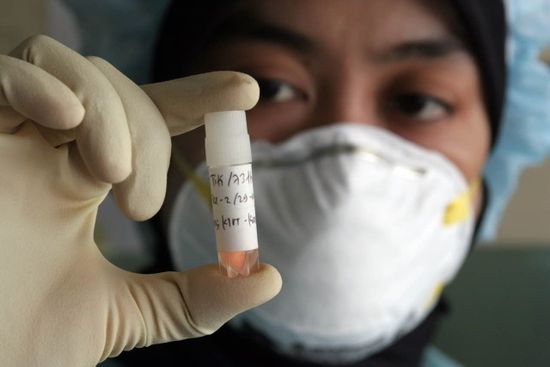
Avian influenza, Cholera, Ebola, Plague, Yellow fever, Meningitis, MERS, Influenza, Zika, Rift Valley Fever, Lassa fever, Leptospirosis, etc.
The past two decades have witnessed changes in how humans live. Travel and trade, rapid urbanization, limited access to health care as well as environmental degradation and other trends all create the conditions for epidemics to thrive and grow. At the same time, the science and knowledge around infectious hazards are constantly evolving, demanding better response to health emergencies. This introductory level online course aims to equip frontline responders with the latest know-how to manage outbreaks of known and emerging epidemic-prone diseases in the 21st century. It offers the most relevant scientific, technical and operational knowledge through video presentations and self-tests.
**Please note: This course was developed in 2017. For the latest updates, please refer to the relevant health topics on the WHO website.
Language: English
English
Basic (Basique), Health topic
Course information
This course is also available in the following language: Français
Overview: The past two decades have witnessed changes in how humans live. Travel and trade, rapid urbanization, limited access to health care as well as environmental degradation and other trends all create the conditions for epidemics to thrive and grow. At the same time, the science and knowledge around infectious hazards are constantly evolving, demanding better response to health emergencies. This introductory level online course aims to equip frontline responders with the latest know-how to manage outbreaks of known and emerging epidemic-prone diseases in the 21st century. This course focuses on 13 infectious hazards: Avian influenza, cholera, Ebola, Lassa fever, Leptospirosis, Meningitis, MERS, Pandemic influenza, Plague, Rift Valley fever, Seasonal influenza, Yellow fever and Zika. It offers the most relevant scientific, technical and operational knowledge through video presentations and self-tests. We hope that you will be encouraged to participate in a discussion board to share the first-hand experiences of your work and to gain new insights from other experts working in this field.
Learning objective: Gain the latest know-how on managing outbreaks of major infectious hazards with pandemic and epidemic potential.
Course duration: Approximately 6 hours.
Certificates: A Confirmation of Participation is available to participants who complete at least 80% of the course materials.
Course contents
Avian and other zoonotic influenza:
Avian influenza is an acute, viral disease of the respiratory tract. It is a severe zoonotic disease with pandemic potential in the presence of sustained human-to-human transmission.Cholera:
Cholera is an acute diarrhoeal infection caused by ingestion of contaminated water or food.Ebola:
Ebola disease can be a severe, often fatal illness in humans.Lassa fever:
Lassa fever, a viral haemorrhagic fever with symptoms similar to those of Ebola virus disease, is endemic in much of West Africa and usually sparks a seasonal outbreak from December to March. Humans usually become infected with Lassa virus from exposure to urine or faeces of infected Mastomys rats.Leptospirosis :
Leptospirosis is a bacterial zoonosis transmitted via contact with rodents, domestic animals and contaminated water. The disease is an emerging public health problem.MERS :
Middle Eastern Respiratory syndrome (MERS) is a zoonotic, severe viral lung infection, with a high case-fatality rate. It is a global threat to human health and it is important to understand the nature of this disease and the ways to prevent, respond to, and control outbreaks of MERS.Meningitis :
Meningitis is an inflammation of the meninges, the lining surrounding the brain and the spinal cord. Public health concerns mainly focus on the bacteria Neisseria meningitidis, as it can cause large-scale epidemics.Pandemic Influenza:
Pandemic influenza is an acute viral disease of the respiratory tract. Pandemic influenza occurs when an influenza virus that was not previously circulating among people and to which most people have no immunity emerges and transmits among people.Plague:
Plague is a zoonotic disease with severe clinical presentations caused by the bacterium Yersinia pestis.Rift Valley Fever :
Rift Valley Fever is caused by a virus transmitted by mosquitoes and blood feeding flies that usually affects animals, but can also involve humans. In humans, the disease ranges from a mild flu-like illness to severe haemorrhagic fever that can be lethal.Yellow Fever :
Yellow fever is an acute viral haemorrhagic disease, found in tropical regions of Africa and the Americas. It is an important public health concern due to the devastating outbreaks it can cause and the risk of international spread.Seasonal Influenza :
Seasonal influenza is an acute viral disease of the respiratory tract transmitted via aerosols or contaminated surfaces from infected people.Zika :
Zika virus disease is caused by a Flavivirus transmitted primarily by Aedes mosquitoes. It emerged in 2015/2016, and although typically a mild disease, consequences of the infection can be severe.
Enroll me for this course
Featured content
Certificate Requirements
- Gain a Confirmation of Participation by completing at least 80% of the course material.